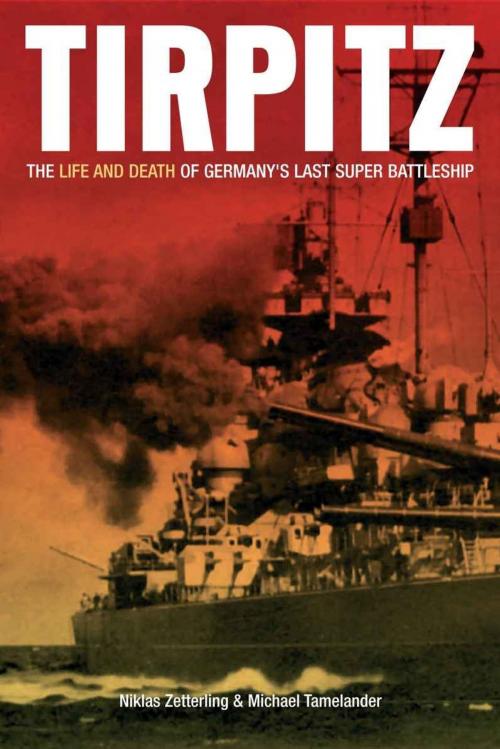Tirpitz The Life and Death of Germany's Last Supper Battleship
The Life and Death of Germany's Last Super Battleship
Nonfiction, History, Military, Naval, World War II| Author: | Nicklas Zetterling Michael Tamelander | ISBN: | 9781612000497 |
| Publisher: | Casemate | Publication: | December 19, 2009 |
| Imprint: | Casemate | Language: | English |
| Author: | Nicklas Zetterling Michael Tamelander |
| ISBN: | 9781612000497 |
| Publisher: | Casemate |
| Publication: | December 19, 2009 |
| Imprint: | Casemate |
| Language: | English |
The story of the battleship TirpitzBismarcks sister shipand the desperate Allied efforts to destroy it. After the Royal Navys bloody high seas campaign to kill the mighty Bismarck the Allies were left with an uncomfortable truththe German behemoth had a twin sister. Slightly larger than her sibling the Tirpitz was equally capable of destroying any other battleship afloat as well as wreak havoc on Allied troop and supply convoys. For the next three and a half years the Allies launched a variety of attacks to remove Germanys last serious surface threat. The Germans for their part had learned not to pit their super battleships against the strength of the entire Home Fleet outside the range of protecting aircraft. Thus they kept Tirpitz hidden within fjords along the Norwegian coast like a Damocles Sword hanging over the Allies maritime jugular forcing the British to assume the offensive. This strategy paid dividends in July 1942 when the Tirpitz merely stirred from its berth compelling the Royal Navy to abandon a Murmansk-bound convoy called PQ-17 in order to confront the leviathan. The convoy was then ripped apart by the Luftwaffe and U-boats while the Tirpitz returned to its fjord. In 1943 the British launched a flotilla of midget submarines against the Tirpitz losing all six of the subs while only lightly damaging the battleship. Aircraft attacked repeatedly from carriers and both British and Soviet bases suffering lossesincluding an escort carrierwhile proving unable to completely knock out the mighty warship. Trying an indirect approach the British launched one of the wars most daring commando raidsat St. Nazairein order to knock out the last drydock in Europe capable of servicing the Tirpitz. Of over 600 commandos and sailors in the raid more than half were lost during an all-night battle that succeeded at least in knocking out the drydock. It was not until November 1944 that the Tirpitz finally succumbed to British aircraft armed with 10000-lb Tallboy bombs the ship capsizing at last with the loss of 1000 sailors. In this book military historians Niklas Zetterling and Michael Tamelander authors of Bismarck: The Final Days of Germanys Greatest Battleship illuminate the strategic implications and dramatic battles surrounding the Tirpitz a ship that may have had greater influence on the course of World War II than her more famous sister.
The story of the battleship TirpitzBismarcks sister shipand the desperate Allied efforts to destroy it. After the Royal Navys bloody high seas campaign to kill the mighty Bismarck the Allies were left with an uncomfortable truththe German behemoth had a twin sister. Slightly larger than her sibling the Tirpitz was equally capable of destroying any other battleship afloat as well as wreak havoc on Allied troop and supply convoys. For the next three and a half years the Allies launched a variety of attacks to remove Germanys last serious surface threat. The Germans for their part had learned not to pit their super battleships against the strength of the entire Home Fleet outside the range of protecting aircraft. Thus they kept Tirpitz hidden within fjords along the Norwegian coast like a Damocles Sword hanging over the Allies maritime jugular forcing the British to assume the offensive. This strategy paid dividends in July 1942 when the Tirpitz merely stirred from its berth compelling the Royal Navy to abandon a Murmansk-bound convoy called PQ-17 in order to confront the leviathan. The convoy was then ripped apart by the Luftwaffe and U-boats while the Tirpitz returned to its fjord. In 1943 the British launched a flotilla of midget submarines against the Tirpitz losing all six of the subs while only lightly damaging the battleship. Aircraft attacked repeatedly from carriers and both British and Soviet bases suffering lossesincluding an escort carrierwhile proving unable to completely knock out the mighty warship. Trying an indirect approach the British launched one of the wars most daring commando raidsat St. Nazairein order to knock out the last drydock in Europe capable of servicing the Tirpitz. Of over 600 commandos and sailors in the raid more than half were lost during an all-night battle that succeeded at least in knocking out the drydock. It was not until November 1944 that the Tirpitz finally succumbed to British aircraft armed with 10000-lb Tallboy bombs the ship capsizing at last with the loss of 1000 sailors. In this book military historians Niklas Zetterling and Michael Tamelander authors of Bismarck: The Final Days of Germanys Greatest Battleship illuminate the strategic implications and dramatic battles surrounding the Tirpitz a ship that may have had greater influence on the course of World War II than her more famous sister.















